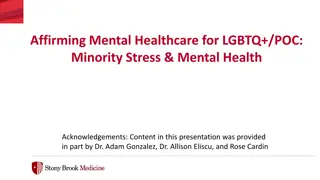Addressing Mental Health Disparities: A Comprehensive Analysis
Explore perspectives on mental health funding and programs, backed by peer-reviewed journal articles. Focus on consequences of limited resources and propose achievable solutions. Emphasize the importance of concrete evidence and diverse viewpoints.
Download Presentation

Please find below an Image/Link to download the presentation.
The content on the website is provided AS IS for your information and personal use only. It may not be sold, licensed, or shared on other websites without obtaining consent from the author. Download presentation by click this link. If you encounter any issues during the download, it is possible that the publisher has removed the file from their server.
E N D
Presentation Transcript
First draft of the IRR due THURSDAY out 3 out 3- -4 copies. 4 copies. 3 peer reviewed journal articles (which you actually use), 6-8 sources overall. 1200-1320 words. THURSDAY Print Print The introduction should end with a thesis statement (this can be the problems/consequences you will be discussing and/or the solutions you reached based on the perspectives you studied). If your paper is divided into sections where each one focuses on a different perspective you analyzed, make sure you are presenting the arguments that the group you are focusing on in that section would make. You must have a wide range of perspectives and draw connections between them! Cite your sources carefully and consistently use either parenthetical citations. Include a bibliography at the end. Parenthetical Citation examples: If there is an author, include the author s last name and the year (Berman) OR (Berman, 1986) If there is not an author, include the title of the article ( Joys of AP Capstone Seminar ) OR ( Joys of AP Capstone, 1986). Make sure the citation is AFTER all the information you have taken from that source. The paper should end with clear and specific conclusions/resolutions. Make sure to be clear about HOW your resolutions can actually be achieved.
Tips for IRRs Be clear where your data is coming from - don t just say a report, provide the name of the report, the credentials of the people who wrote it, etc. Flory and Friedrich, co-directors of the National Alliance for the Mentally Ill Long- term Care Network, provide examples of the effects caused by limited funding through the complaints of families who have directly experienced the unsuccessful community centers. Madianos,president of the World Association for Psychosocial Rehabilitation and professor of general and social psychiatry at the University of Athens, delineates the direct correlation between the economic level of a country and availability of mental health programs. Make sure all of your paragraphs/perspectives are related to your lens Make sure your solutions are actually consistent with the evidence you presented.
Tips for the IRR Make sure that every claim you make is backed up by concrete evidence! Provide as much quantitative data as possible to support your argument. A generalization is still a generalization even if it can be supported by a scholarly citation.
This is what a citation in the bibliography should look like (indent starting with the second line): Love, Robert. "Before Jon Stewart: the truth about fake news. Believe it." Columbia Journalism Review, vol. 45, no. 6, 2007, p. 33+. General OneFile, http://link.galegroup.com/apps/doc/A164948232/GPS?u=nysl_li _mhhs&sid=GPS&xid=98a955ed. Accessed 28 Apr. 2019.
Parenthetical Citation for a Source with Multiple Authors (Hall et al.)























